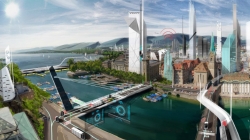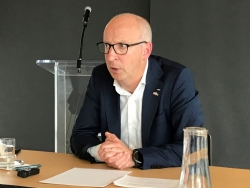Volvo’s vision automated, electrified, connected
 WASHINGTON, DC – Change is said to be one of the certainties in life, and Volvo Trucks is preparing for a future that is electrified, automated, and connected. But the company doesn’t expect fully autonomous or electric linehaul trucks anytime soon.
WASHINGTON, DC – Change is said to be one of the certainties in life, and Volvo Trucks is preparing for a future that is electrified, automated, and connected. But the company doesn’t expect fully autonomous or electric linehaul trucks anytime soon.
“It’s a time of revolution when it comes to engineering and technologies,” Chief Technology Officer Lars Stenqvist said during a media roundtable in Washington, DC. “This is the most fascinating and challenging era ever.”
While Volvo expects electric trucks to emerge, the company’s electrification strategy is focusing on applications like ports, urban centers, and construction rather than the open road.
“The biggest interest is the ability to have the ability to go electric the last leg, the last mile,” he said.
Ongoing tests by Volvo Group, for example, involve a Mack Pinnacle drayage vehicle that uses GPS to decide when to switch between its combustion engine and electric motor. Other initiatives include construction equipment like an electrified compact excavator and an autonomous load carrier. And its most extensive electrification experience involves buses, such as an ongoing research project underway in Montreal.
“Components, when it comes to electrification, [are] available inside the group, and it’s definitely one of the technologies we will use for North America,” he said.
The future isn’t limited to electrification, of course. “The death of the combustion engine is not today, it’s not tomorrow, it’s not in 10 years,” he added, referring to gains still being realized by layering new technology on diesel engines, which have been around in some form or another for 141 years. Stenqvist cited as proof the 2% fuel economy boost realized by reshaping piston bowls into what has become known as the Wave piston.
Regional and linehaul applications are more likely to involve hybrid solutions that recover energy otherwise lost through braking, he said, looking to the future. Later, the electrification might draw on the surrounding infrastructure as well as the vehicle itself. Volvo is already partnering with Siemens to test the concept of using overhead wires to power vehicles, perhaps along dedicated corridors.
Volvo is not about to abandon its focus on vertical integration, which has it developing powertrains and trucks alike. “We’re not deviating from the path of having control of the components in our vehicles,” he said. But there are still other opportunities to partner with other Tier 1 suppliers and other technology companies. “I’m surprised to see who’s calling us, because it’s small start-up companies.”
The smaller players may not have all the answers, but many can provide a significant piece of technology, particularly when it comes to connectivity. When those technologies converge, Stenqvist added, “We will see a radical shift.”
Some of the gains will be realized through increasing computing power in vehicles themselves, particularly against the backdrop of the Internet of Things. Most recently, Volvo has introduced over-the-air engine programming that can be completed without a truck rolling into a service bay.
Connected infrastructure offers the change to share more data about everything from congestion to the weather, too. Connect the vehicle data to infrastructure, and equipment could be better utilized, he said. “There’s a lot of possibilities opening up when you get everything connected.”
Geofencing already allows city buses in some parts of the world to automatically restrict speeds on specific routes. “It can also be dynamic,” he observed, noting how speeds could be restricted in areas known for heavier levels of pollution.
Trucks are already being connected, of course, but these are early days yet. Adds Stenqvist: “[We’re] rich on data, poor on knowledge.”
Automation
 Then there’s the question of who – or what – will actually drive the trucks. Automation is much more than discussions about driverless trucks might indicate, Stenqvist said. The five recognized levels range from advanced cruise controls to support the drivers, to technologies that help keep the vehicle in a lane, vehicles that take control for a specific period of time, and ultimately those that run on their own with or without a driver in the cab.
Then there’s the question of who – or what – will actually drive the trucks. Automation is much more than discussions about driverless trucks might indicate, Stenqvist said. The five recognized levels range from advanced cruise controls to support the drivers, to technologies that help keep the vehicle in a lane, vehicles that take control for a specific period of time, and ultimately those that run on their own with or without a driver in the cab.
The highest levels of automation are likely going to emerge in fully controlled environment, he said. Last year, for example, Volvo introduced a fully autonomous vehicle that runs 1,300 meters below the ground in a mine in Northern Sweden. “That’s the kind of environment where we believe we will find fully autonomous vehicles emerging,” he said. Quarries and harbor terminals offer other options.
When autonomous vehicles do begin to emerge on the highway, he expects they will be limited to dedicated lanes, perhaps physically separated from other vehicles.
Still, some of Volvo’s work extends into suburban areas, as it researches the potential of an autonomous refuse vehicle that will follow a walking driver much like a dog, as waste is loaded into the hopper. “He doesn’t need to step in and out,” Stenqvist says of the European trial.
“We’re learning a lot and are convinced something in this range will be commercialized,” he said.
Demonstration projects like this help to ease public anxiety, he adds. When first presented with the idea of autonomous technology, people want to know “the maximum speed of this monster”. The opinions improve once they see how quickly safety systems can engage, especially on a truck that crawls along at 5 km-h. The barriers to accepting those that travel at highway speeds are a different matter.
“We have a lot of public skepticism to overcome, and we need to be humble and honest,” he said.
The challenges that range from rising congestion to the fight against emissions continue to grow. “We need to come up with these solutions rapidly,” Stenqvist added. “The world is waiting.”
Have your say
This is a moderated forum. Comments will no longer be published unless they are accompanied by a first and last name and a verifiable email address. (Today's Trucking will not publish or share the email address.) Profane language and content deemed to be libelous, racist, or threatening in nature will not be published under any circumstances.